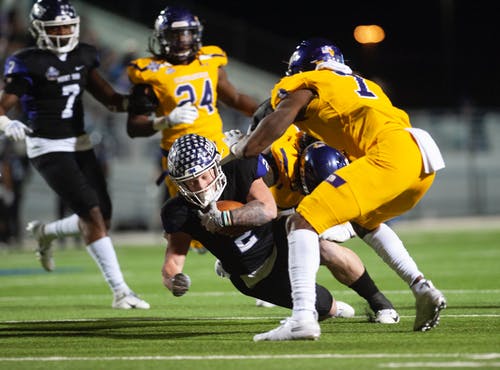Should athletes do aerobic training? This has been a pretty good debate for a number of years. One side of the debate is going to say that of course aerobic fitness is important and there are several reasons for this. First, it develops cardio-vascular fitness. Second, we use the aerobic energy system to recover therefore that energy system needs to be developed.
With this article we’re going to look at this, play Devil’s Advocate, and present some thoughts about how to integrate this in a team situation.
Let’s begin by looking at the con’s of integrating an aerobic fitness program for non-aerobic sport athletes. This include:
- Lack of research: If developing the aerobic energy system will enhance recovery from anaerobic work, then there should be a link between maximal oxygen consumption (the measure of aerobic fitness) and the ability to recover from anaerobic work like sports practices, strength training, sprints, plyometrics, etc. I’m not aware that this link has been established.
- Training time and recovery are finite: Training aerobic fitness takes time. By definition it takes at least 20 minutes of non-stop, rhythmic activity. First, athletes at all levels have a very limited amount of time with which to train. Second, athletes have a limited ability to recover from training. This also creates practical challenges of how to integrate this type of work with all the other work an athlete does (for example, if I squat heavy today then when do I jog?).
- Can lead to injuries: Aerobic exercise involves movement being repeated for an extended period of time. This can lead to overuse injuries, especially to larger athletes. For example, cross country runners are built for five mile runs but offensive linemen are not.
- Will interfere with gains; Aerobic training develops the aerobic energy system along with slow-twitch muscle fibers. This could be at the cost of developing anaerobic energy pathways and fast-twitch muscle fibers. In other words, for anaerobic athletes this could interfere with performance.
Having touched on some of the con’s behind using aerobic training for non-aerobic athletes, there are a few things to consider. First, most of us are not working with elite athletes. This is a hard one to admit, but by definition there just aren’t that many elite athletes – means most of us aren’t there. That suggests that concerns about energy system dominance and fast twitch muscle fibers might be misplaced.
Second, and this is important to keep in perspective, most of us are coaching athletes to teach life skills, this is very different than developing professional or elite athletes. One of a strength and conditioning coach’s roles is to help teach life skills. Part of this is teaching a lifelong appreciation for a well-rounded fitness program. For example, expecting individuals to be able to walk up a flight of stairs, or across a parking lot, without collapsing isn’t expecting too much.
Now, in reality running for several miles at a time isn’t practical for most athletes. It’s just too time consuming and there is too much risk of overuse injury especially when we’re also squatting heavy, deadlifting, cleaning, snatching, sprinting, and performing plyometrics.
One of the training tools that has come up in recent years to help address this is high intensity interval training. In a 2001 Sports Med article, Larsen and Jenkins define high-intensity interval training (HIT) as repeated bouts of 10-300 second bouts of exercise completed at an intensity that is greater than anaerobic threshold. These exercise bouts are then separated by brief periods of low-intensity or inactivity that allows for partial recovery. According to the authors this is a very effective approach to training to improve aerobic fitness, but it needs to be emphasized that most of the studies that they look in their review are dealing with endurance training (running and cycling primarily).
Some have adapted this idea to the conditioning of athletes in non-aerobic sports. Jay Dawes and I wrote a book about this. Briefly the idea is the address the conditioning needs of the sport using a variety of exercise modes and implements while using work:rest ratios that meet the needs of the sport. This type of training is flexible enough that it can last for as long or as little as is needed. Using this type of training is also conducive to the large groups of athletes that most coaches encounter.
Using high intensity interval training for conditioning means that almost all the strength and conditioning implements and modes can be used. This allows for the setting up of stations that can accommodate several athletes at once.
For example, we’re working with an American football team. We know that in football we can analyze the lengths of plays, their distances, how many are in a series, how many series per quarter, how many per game, etc. We can also develop a range (best case and worst case) and we can use all this data to develop a metabolic conditioning program.
In Plisk and Gambetta’s groundbreaking 1997 article they presented an example using the 1991-1992 NFL playoffs and noted an average (for the Washington Redskins offense) of 5.5 yards per play, 5-10 plays per series, and an average of 16 plays per quarter. With this in mind we’d be looking at 4-5 seconds of work and 40-45 seconds of rest and we could put a metabolic conditioning program together to address these variables (for example, 16 cycles of 5 seconds on and 40 seconds off). The authors use sprints as an example, though I like to avoid this because it can build bad sprinting habits.
To keep the math easy we’ll say we are working with 50 athletes on the varsity high school football team. We can set up ten stations, with 5 athletes at each station. This means we only need five sets of equipment per station which is a lot more manageable than having 50 sets of equipment. An example of a program might look like:
Kettlebell swings
Jump rope
Front lunges
Plank
Inchworms
Bear crawls
Tire flip
Rear lunges
Marches
Sled pull/push
The work:rest ratios could be set to whatever is needed, and this circuit could be repeated as many times as necessary to achieve the desired results.
References:
Larsen, P.B. and D.G. Jenkins (2001). Optimizing training programs and maximizing performance in highly trained endurance athletes. Sports Med 32(1), 1-22.
Plisk, S. and V. Gambetta (1997). Tactical metabolic training, part I. Strength and Conditioning, 19(2), 44-53.



